Richard Ouzounian, theatre critic for the Toronto Star
(Source)
Richard Ouzounian, theatre critic for the Toronto Star
(Source)
Quote
—
Posted: August 20, 2013 in Future of Toronto Theatre, General, Toronto Theatre
Tags: Richard Ouzounian, Theater, Theatre, Toronto, Toronto Star
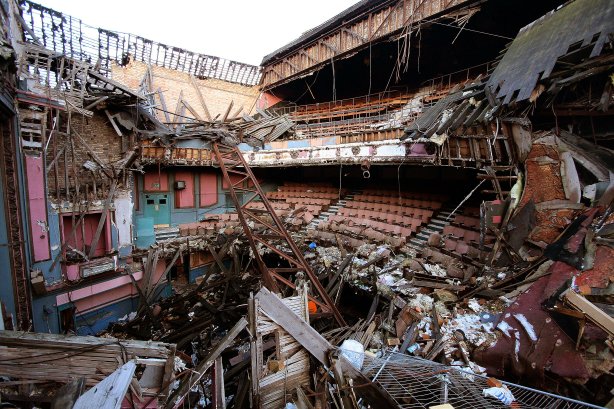
Derby Hippodrome, Derby UK. Opened in 1914. Operated as a theatre until 1930, then a cinema until 1950 then again a theatre until 1959. Used as a bingo hall from 1962 onwards. Illegally partially demolished in 2008 by a developer. Now owned by the Derby Hippodrome Restoration Trust, who have set up a campaign to raise £15 million to restore it. Photo by Adam Slater
(Source)
A study done by the City of Toronto in 2008 revealed that the top reason tourists visit our city was theatre.
Yes, theatre.
Not baseball or hockey or our museums or our shopping or even the CN Tower.
Theatre.
The study also identified that the lack of original productions unique to Toronto was an issue and partly the cause of the city’s tourism decline (Can I say “I told ya so” yet?).
Still, little is being done to correct the problem. Mirvish continues to present mostly touring productions with the exception of this year’s sit-down of a new staging of Les Miserables which already is drawing ticket sales from people outside of the Greater Toronto Area, including the important U.S. market, because of its stars Ramin Karimloo and Earl Carpenter. The pre-Broadway try-out of Aladdin should also see a spike in tourist visits, although with it heading to Broadway, most American audiences will wait to see it there.
But then there’s the tale of Evangeline, the new Canadian musical about the Acadian Expulsion by Ted Dykstra now having its world-premiere run at the Charlottetown Festival. In an interview with the Globe and Mail, Dykstra reveals that the original musical almost never made it to the stage at all after first approaching Mirvish Productions who initially loved the script and invested $500 000 for development, bringing in a Broadway writer to ‘fix it’. Instead, Dykstra says, the Mirvish team wanted to inject more “sex, violence and ‘kitchen sink’ realism” into the project to make it edgier. The collaboration fell apart and Mirvish was unwilling to invest any more money so the musical was set aside, all but forgotten until Dykstra was convinced to dust it off and bring it to the Charlottetown Festival where it has earned good (but not great) reviews and strong ticket sales consisting largely of tourists. The festival had been suffering from steeply declining audiences until 2011, when the decision was made to revamp their production of Anne of Green Gables – a show that had been re-staged annually at the festival since 1965 – to experience an 85% rise in ticket sales. Evangeline is seeing audiences travel from across the country and beyond to see it and, along with Anne’s updating, has been revitalizing the once-floundering festival. Evangeline marks the first time a large-scale, original musical has been produced in Canada since Mirvish’s The Lord of the Rings in 2006
Meanwhile, most eyes in the global theatre industry continue to watch Australia for new musicals. Global Creatures‘ adaptation of King Kong, which has now opened in Melbourne to good reviews (again, not great, but still good) and playing to sell-out crowds. Because Kong can only (for the moment) be seen in Melbourne, a healthy portion of those crowds will be tourists. Producers have made it clear that if you want to see the production, you’ll have to travel to Melbourne and have even gone so far as to offer a money-back guarantee if the show opens anywhere else in Australia, unlike the country’s last must-see hit production of Love Never Dies which played in Melbourne then Sydney and became one of the top theatrical earners in Australia in 2012. Next year, Baz Luhrmann’s musical adaptation of Strictly Ballroom will have its world premiere in Sydney and is quickly becoming the next ‘show to watch.’

Adam Brazier and Chilina Kennedy star in the Charlottetown Festival’s world premiere production of EVANGELINE
The Stratford Festival is having a very good season, with over thirty thousand more tickets sold than last year and American tourism up %11 and climbing. When asked the reason for this, Stratford’s executive director Anita Gaffney credits the economic turnaround following the recession and, more importantly, the productions at Stratford that audiences “could not see closer to home.”
None of this happens in Toronto. The closest thing we’ve had to a large scale original musical since The Lord of the Rings was Theatre 20’s Bloodless: The Trial of Burke and Hare, a disaster on all fronts. Bloodless was a critical bloodbath and before it, The Lord of the Rings failed to find an audience following poor reviews and closed after a few short months. Neither company has produced an original, full-scale production since. While King Kong and Evangeline are enjoying success and wide-spread media attention as original musicals, Lord of the Rings and Bloodless’s poor reviews told tourists to stay away. Rings tried to condense three massive, well loved novels just coming off the success of three film adaptation into one three-hour stage production. Bloodless was praised for its cast but its book and music lacked cohesion and originality (even Theatre 20 kept comparing it to Sondheim’s Sweeny Todd) and the production was poorly directed by Theatre 20 Artistic Director Adam Brazier (who, coincidentally, is currently starring in Charlottetown’s Evangeline).
I can’t over emphasize how vital tourism is to the theatre industry, whether it’s a small-town summer theatre or a Broadway house (63% of Broadway audiences are tourists). Despite its importance, Toronto’s theatre tourism levels are shockingly and embarrassingly low. Our theatre companies don’t seem to understand how important theatre tourism is, let alone why tourists are not sitting in their seats and they seem to be unwilling or unable to correct the problem. Toronto needs theatre companies that produce more quality original productions of new and existing shows. Shows that cannot be seen anywhere else and will run longer than two or three weeks by companies that know to market these shows not just outside of Toronto or the GTA, but outside of the province and country. Without doing what needs to be done to boost theatre tourism, Toronto theatre doesn’t stand a chance.
SoulPepper Artistic Director, Albert Schultz on The Canadian Stage Company’s dramatic decline in audience after a recent change in mandate
(Source)
Quote
—
Posted: July 27, 2013 in Administration and Management, General
Tags: Albert Schultz, CanStage, Soulpepper, Theater, Theatre, Toronto
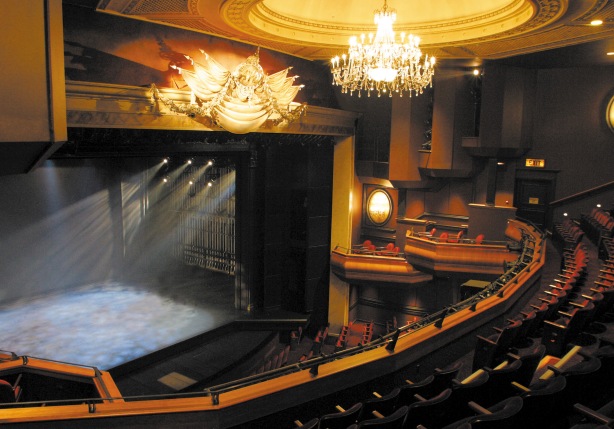
Avon Theatre – 1090 seats. Part of the Stratford Festival in Stratford, Ontario. Originally built as the Theatre Albert, a vaudeville house opening in 1901. By the 1950’s was used almost exclusively as a movie theatre. Purchased by the Stratford Festival in 1963 and, over the years, extensively renovated culminating in a massive renewal project completed in 2002 with the structure as it stands today – one of the best live theatre venues in the province. Sadly, most famous for being the theatre where Justin Bieber sat busking on the front steps before finding fame.
Photo by Terry Manzo
(Source)
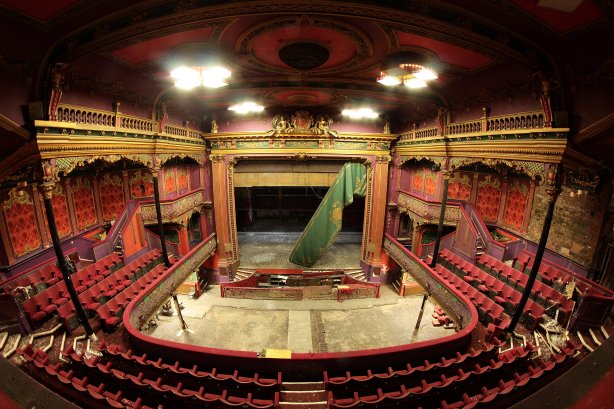
Hulme Hippodrome, Manchester. Opened in 1901. Operated until the mid-1960’s, then used as a bingo hall until closing in 1986. Photo by Adam Slater
(Source)
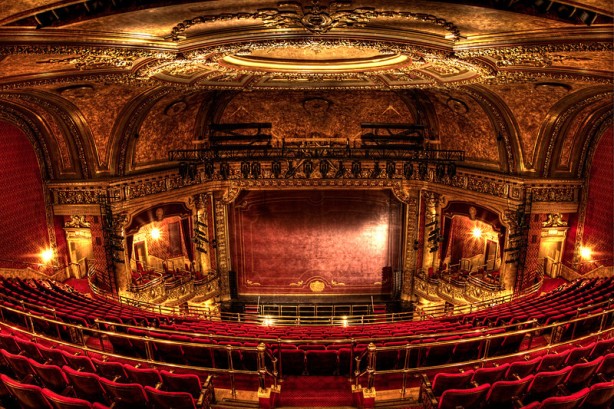
The Elgin Theatre 1561 seats. Built in 1913, it will celebrate its 100th birthday on October 7th this year. Flagship of Marcus Loew’s legendary theatre chain. National Historic Site along with the Winter Garden Theatre upstairs and together are the last of the ‘Double Decker’ theatres in the world. Used in several scenes of the film adaptation of Chicago. Venue for the Toronto International Film Festival. Home of the original Canadian production of Andrew Lloyd Webber’s Cats before it was closed for restoration in the 80’s. Also home of the original Canadian production of The Who’s Tommy and world premiere of Napoleon in the 90’s
Photo by Edith Levy
(Source)
A recent announcement from Vancouver revealed that it is losing another theatre, the 1836-seat Centre in Vancouver for Performing Arts. Originally built in the 90’s by Garth Drabinsky as the Ford Centre for the Performing Arts (a sort of West Coast sister to his North York theatre of the same name, now the Toronto Centre for the Arts), the venue was the temporary home to many Livent tours including Showboat, The Phantom of the Opera, Sunset Boulevard, Ragtime and others but like the theatre industry in Toronto fell victim to the Livent scandal and was eventually purchased by Four Brothers Entertainment in 2001, a company founded by four Hong Kong-born, Colorado-based brothers who started as doctors and real estate moguls, then dabbled in film and theatre production.
The announcement, which follows last year’s sudden closure of the Vancouver Playhouse, was accompanied by University of British Columbia theatre professor and theatre critic Jerry Wasserman’s testimony that the Centre’s loss (to be purchased by a religious organization and converted into a place of worship) is no big deal and won’t be missed because Vancouver already is home to two theatres over 2000 seats – the 2765-seat Queen Elizabeth Theatre and the historic, 2672-seat Orpheum (most famous as a filming location for the re-imagined Battlestar Galactica series) – and couldn’t support all three barns. As part of his argument, he says “Vancouver is not New York, it’s not Toronto, it’s not Los Angeles, it’s not Chicago. Those are the kinds of cities that can accommodate more than one or two 2,000-seat theatres.” Well, news flash, Broadway doesn’t accommodate that large of theatre either. The average Broadway house is between 1000 and 1200 seats, the largest being the Foxwoods Theatre, home of Spiderman: Turn Off the Dark at 1900 seats. Toronto has the behemoth Sony Centre for the Performing Arts at 3191 seats, but that venue is more often used for concerts and special events than traditional theatre. The next largest theatre we have is the Ed Mirvish at 2300 seats followed by the Four Seasons Centre, used most of the year by the Canadian Opera Company and National Ballet of Canada, at 2071 and the Princess of Wales at an even 2000. The Ed Mirvish and the Princess of Wales are both owned by David Mirvish, Toronto’s only full-time commercial theatre producer, who is also claiming that we have too many theatres for the city to sustain in order to justify his decision to tear down the Princess of Wales to build condos. But wait a minute – The Ed Mirvish Theatre has been home to a sit down production of The Wizard of Oz all year with the new musical Disney’s Aladdin opening there in the fall before heading to Broadway and the Princess of Wales has been busy with a very well attended sit down production of War Horse followed by a sold out run of Book of Mormon which will be followed by Anything Goes this summer and a new, sit down production of Les Miserables starting in the fall, then return engagements of The Lion King and Mormon next year. Mirvish owns two other theatres – the Panasonic, which has been busy with the company’s Off-Mirvish subscription series as well as comedy shows and lectures and at the moment is the home for the new Toronto production of Cats, and the Royal Alexandra, which has been used to house… well… crap (and more crap), the only bright spot on its schedule is the upcoming tour stop of Once. So despite claims to the contrary, our theatres are pretty busy… at the moment at least.
Back out west, at the other end of the spectrum is Brent Belsher, a Vancouver producer and arts consultant who started a petition and Facebook page to have the City of Vancouver step in and block the sale of the Centre. He insists that the failure of the Centre was due to programming, which consisted of occasional productions created for the local Asian community with the intent to travel to Asia, annual presentations of The Nutcracker by the local Goh Ballet Academy and once in a while a concert or lecture, not the size or number of theatres in the city. Belsher is %100 correct. At 1800 seats in a city with a population of over 2 million (with millions more in the surrounding area, also being close to the US border), the Centre should be profitable if the owners have the industry knowledge to book productions that people want to see. The venue could easily out-perform the larger civic owned theatres in Vancouver but you can’t run a theatre of that size by targeting one demographic no matter what city you’re in. Four Brothers Entertainment could have been filling the theatre week after week with the many popular tours currently traveling the continent but looking at their bookings for the past year, a week of Rock of Ages over a year ago is the only Broadway tour they have hosted. There are many weeks, and even an entire month, where the venue has sat dark. The failure of the Centre lies not with the venue itself, but with the management who have been unwilling or lacked the knowledge to use the theatre to its full potential. Under a knowledgeable producer, the Centre could not only thrive but be a tent pole for the Vancouver performing arts industry.
Despite that, Wasserman continues his argument saying small theatres in the 350-seat range are the way to go, an argument also heard often here in Toronto. I’m tired of hearing it. On top of the several small-to-mid size venues Toronto already has, we are adding at least three new ones: The Theatre Centre and The Crow’s Theatre both are building new homes and The Daniels Spectrum in Regent Park opened late last year. Sure, these small theatres are great for community groups, small-time independent producers and non profit companies for short-run, low-budget productions and are important to a community’s arts and culture ecology, but small theatres alone cannot sustain or grow a city’s theatre industry. They do nothing to attract tourists (a vital demographic), their productions (with rare exceptions) don’t move on from their initial run (at least the ones Toronto is producing) nor do they earn the revenue required to afford artists a sustainable way of life. Big theatres, with the right programming, can do all of these things.
Here in Toronto, there is still the Mirvish venue monopoly, the threat of losing the Princess of Wales to unneeded condos and the local government is still trying to decide what to do with the civic-owned theatres. The Toronto Star’s Martin Knelman recently published an article arguing that of the three subsidized theatres, the city should save The Sony Centre “at any cost” and I agree %100. As he points out, not only do the two other theatres need more tax payer dollars than the Sony (Jim Roe of the St Lawrence Centre went on record saying the theatre he manages will never be self-sustaining, which is another blog altogether), but the Toronto Centre for the Arts will be sitting empty indefinitely now that Dancap no longer produces there (and is in a terrible location anyway) and the St Lawrence Centre, horribly outdated and unattractive, is being used less and less by resident company CanStage (who’s programming isn’t popular enough to fill the 876 seats these days). Instead it should be torn down and replaced with a better facility financed by a developer. A venue similar in style and size to Stratford’s Avon Theatre, free of CanStage’s implosion, would make a perfect addition to Toronto’s collection of theatres and would undoubtedly be the venue most sought after by producers. If only the Ontario Heritage Trust, owners of the Elgin and Winter Garden Theatres, would make their venues more affordable to rent, producers would have the freedom to present more shows that Toronto often misses out on and even make the city a place to launch new large-scale works again.
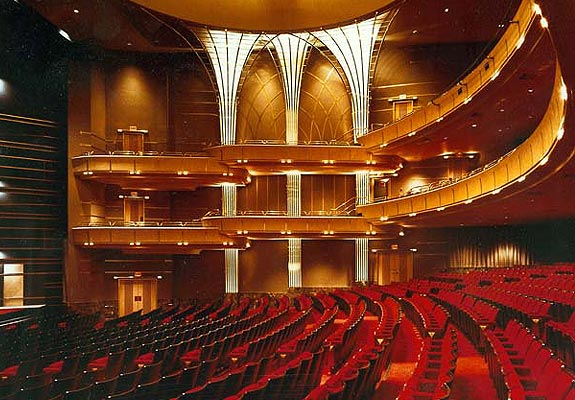
Toronto Centre for the Arts, Main Stage. 1727 seats. Formally known as the Ford Centre for the Performing Arts. Opened in 1993 with the world premiere of the Livent revival of Show Boat. Also housed the Canadian production of Jersey Boys (Dancap Productions) and Andrew Lloyd Webber’s Sunset Boulevard (Livent), among many others.
(Source)